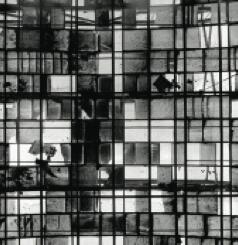Leo Matiz
Ideobox, Miami
Paris Éternel, 1944: feux de la liberté, at Ideobox Art Space, and The Expanded Eye, curated by Osbel Suárez for the Miami Biennale, show facets of Leo Matiz’s (Aracataca, Magdalena, 1917– Bogotá, 1998) all-embracing eye. Of his hunger for light and shadows, for horizons, for forms, for ways of revealing the poetics of the unceasing human adventure, the exhibitions highlight, on the one hand, the metaphor for the freedom of humanity represented by fireworks in the sky of a historical day; and on the other, the solitary existence of the things that the human eye disdains.

Matiz imprints forever on a photographic plate a light ray on a wall, the symmetry of a cactus, the geometries of the architectures under construction rising towards the sky, the splendid silhouette of ordinary scaffoldings, the visual parable of things repeated and aligned metal bars, vessels, metal bands, boxes that speak of a silent exploit.
For the staging of The Expanded Eye, Suárez built a small movie theater featuring two videos mounted in loop that show Matiz’s visionary gaze regarding the birth of modernism in Caracas Leo Matiz in Caracas, 1950s, directed by Alejandra Szeplaki for the Foundation for Urban Culture in Caracas, Venezuela, and his own biography, inseparable from the eye transformed into a lucid camera, even after having lost it in an accident, as he himself narrates in the film shot in Italy by Susanna Francalanci, Roberto Magrassi and Silvia Salamon. For Matiz attains the absolute instant in which the image speaks in the midst of the silence: that “closing your eyes, just allowing the detail to rise of its own accord into affective consciousness,” to which Barthès makes reference.
He can capture an echo of Mondrian on a large window, and his eye also captures the workings of light directly, without his having to resort to Lászlo Moholy-Nagy’s stills technique. He shares with master Bauhaus the fascination with architectures. His camera bears testimony to the prodigious decade of the 1950s in Caracas, and he will return once and again to the multiplication of buildings. Instead of the aerial shot in Andre Kertesz’s famous Under the Eiffel Tower, Matiz resorts to low-angle shots and to the contrast between stone (or iron and cement) and the sky. In Bogotá, Guatemala City or Barranquilla, he photographs the dynamics of the cities in-the-making.
Although the exhibition encompasses the abstract qualities of the natural world and of human constructions, the curator has cleverly included several images in which the silhouettes of the workers are incorporated together with the structures, since Matiz’s work, like Whitman’s, constituted a hymn to the laborers of the land. In addition, the exhibition condenses his fascination with the integration between art and architecture, but it also explores the fascination of the eye with the perfect geometry of leaves and humble construction materials. Parallel to this, in Paris Eternel: Feux de la Liberté, Alejandra Matiz not only exhibited a fantastic and little-known series of her father’s works, the photographs of the lights originating in the fireworks with which Paris (and the whole world) celebrated the end of the Nazi nightmare on that memorable 24th of August, 1944, but she also resorted to the unusual process of printing the negatives of each image. Both processes highlight Leo Matiz’s ability to capture, in the fleeting and prodigious vision of all things, the traces of history and of the infinite.





